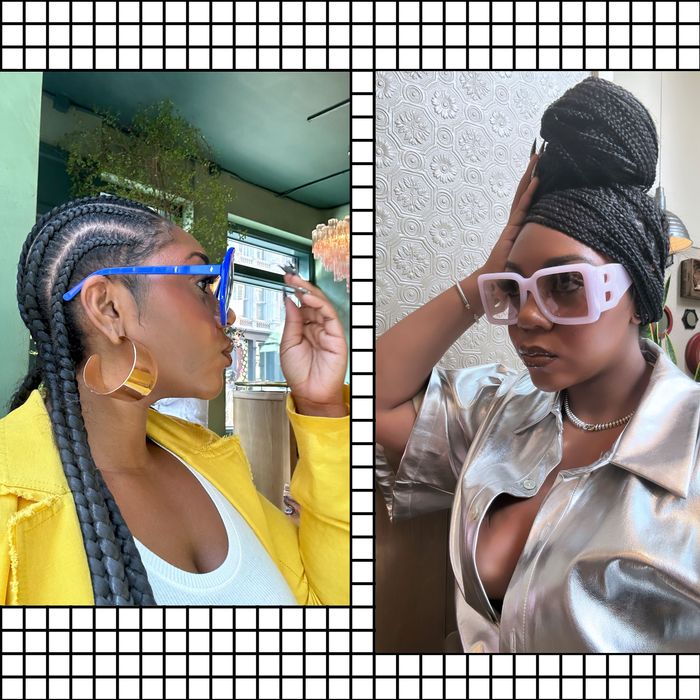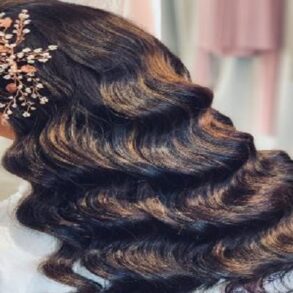
As a child, I hated braids. Every summer, my mother insisted on putting cornrows in my head with colorful beads. Like many young Black girls, I couldn’t stand the pulling and the time it took, but as I got older, I understood why she did it: It saved time and made mornings much easier. In my early 20s, I started a daily routine of going to the gym and traveling more frequently, so I tried knotless braids again. They quickly became a summer staple for me.
My inquisitiveness about proper care for braids grew — how to wash them, different styles, different types of hair. Last year, I came across something I never knew existed: sustainable plant-based braiding hair. As someone who has seen success in wearing hair extensions from multiple companies and buying braiding hair from the beauty-supply store, I couldn’t understand why we’d need to fix something that wasn’t broken.
Ciara Imani May, founder of Rebundle, explained that, for her, it was about her scalp. May wore synthetic hair while growing her hair out and getting her hair braided back-to-back, and her scalp became inflamed and irritated. “It was uncomfortable to go to work, and it was uncomfortable to live in,” she tells the Cut. “I just felt like I didn’t need to suffer through it.”
Osahon Ojeaga, the founder of Nourie Hair, had a similar situation. She started wearing her hair in braids at 6 years old, but as she got older, her scalp grew more and more irritated. “I was getting a lot of breakage from wearing synthetic hair,” she says. “My scalp was so irritated that I started getting patch alopecia, and my hair just stopped growing. My dermatologist told me it was the materials I was using on my hair, and I just had to shave it all off.”
Hair becomes our identity as Black women, so having hairstyles that not only make us look good but feel good is essential. Inflamed scalps and irritation can be dreadful, scary, and embarrassing, but both May and Ojeaga turned their experiences into businesses that are helping other Black women with their own hair struggles. I tried out both hair extensions to see what it really feels like to wear plant-based hair. Here are the pros and cons of my wear test of both sustainably sourced hair-extension brands.
Rebundle
Photo: Asia Milia Ware
Rebundle launched in 2021 as a solution to both scalp irritation and the plastic pollution that synthetic hair produces. “We wear it, we toss it out, we get it redone, and we go on about our lives, but the need for more sustainable options has been apparent for some time,” May says. “What Rebundle brings to the table is an option that is both safe and non-itch and biodegradable after use.” These plant-based extensions are made from banana fibers and are chemically processed in St. Louis, Missouri, by May’s team. Rebundle’s unique patent is on taking the design from strawlike to hairlike. For my wear test, I got small knotless braids. My stylist, Xia Charles of Braided New York, has done braids for celebrities like Beyoncé and Cardi B, so I trust her to put plant-based extensions on my head. I kept the braids in for three weeks. There were pros, but there were also cons.
Pros
Color variety: The hair is available in eight different colorways, from a natural dark brown to bubblegum pink to a deep ocean blue. You can be playful with it. Plus, it doesn’t exclude people who may have a different natural shade of hair.
Flexibility: I was able to style this hair as I wanted without its being too stiff or unmanageable, which had been one of my concerns.
Multiple lengths: I used 18-inch hair, which was a mistake because it took longer to install the braids and I had to add other hair to get my desired length. But the hair is available in three lengths — 18, 22, and 30 inches — based on the style you want to get.
No itching or scalp irritation: The hair definitely works for what it’s meant to do. My scalp never felt irritated or super-itchy while wearing this hair. Normally when I sweat after workouts, my scalp will itch as it dries, but I didn’t experience that with this hair.
Cons
Styling: What would normally take my stylist six to seven hours took ten hours because this hair can be tough to deal with. Its dye was transferring onto Charles’s fingers along with the hair’s coating, which felt waxlike and sticky. Sitting in a chair to get a full head of braids already takes a long time, so the added hours were a con.
Price: The price of getting braids has skyrocketed in recent years. Knotless ones usually start at around $300. Synthetic hair in the beauty supply goes for about $10 a pack, and two packs are usually enough for a full head of braids. Rebundle starts at $45 for a pack, and with the 18-inch hair, I needed about four packs that still were not enough, so I ended up having to mix the braids in with synthetic hair. It set me back $180. May knows the price is high and wants her community to look at purchasing Rebundle as an investment. “This is an investment, especially if you are someone that has a sensitivity to plastic hair,” she says. “It’s not for the person who has no irritation, has no care for the environment, and is not trying to make an investment.” May wants women to be okay with spending extra money on hair extensions for braids just as they’d be okay with spending $90 on one bundle of weave for a sew-in. May is doing something very new that hasn’t been done before, so she doesn’t have a blueprint to follow; she’s creating her own, which means that sourcing quality fibers and processing the hair costs a lot more than something already on the market.
Smell: There was a slight hint of a banana scent on the hair, which I assumed came from the use of banana fibers. It wasn’t unbearable, but I did find myself using more hair perfume than normal.
Longevity: I wore my braids for three weeks, which is normal for me with a knotless style. I did ponytails and buns, wore it down, and lived my normal life. I worked out every day and traveled with it, and while it lasted well and was flexible enough to style, the braids frizzed up a bit quicker than my braids normally would, and I found that they shed a lot.
Would I wear it again?
After I took the braids out, my first response was “no.” It took extra time, and I didn’t like the frizziness as the weeks went on. But after chatting with May, I determined to try it again for braiding my hair under a sew-in weave. The braids under my weave normally itch, causing me to take my hair out earlier, but I would invest in this hair to relieve itching and scalp irritation under weaves. “We’re targeting Black girls who wear braids — but not every Black girl who wears braids today because we are not all the same and our priorities are not all the same,” May told the Cut. In this case, my priorities for my hair are different.
Nourie Hair
Photo: Asia Milia Ware
Nourie Hair launched this year and is still in its preorder phase. The brand sources plants to build its hair fibers — and not just one but multiple building blocks of a plant that it then engineers at a molecular level. The hair releases nourishment to the scalp and the hair over time, and when you touch it, you can feel the rich moisture embedded in its fibers. Nourie Hair’s goal is to approach scalp health like skin care, so the hair contains ingredients like jojoba, ginseng extract, and rosemary to promote hair growth and have antifungal properties. Since the hair is meant to nourish the scalp, I went with a style that sat directly on mine: cornrows. Charles braided my hair in six straight-back cornrows with these plant-based extensions, and I wore them for a little over two weeks.
Pros
Scalp care: Our scalp is an extension of our skin, and I think scalp care has become a lost art. So the fact that this hair is not only meant to be sustainable but also moisturize the scalp was important to me. Oftentimes the scalp becomes dry over time with braids in, especially from the tension of the style, but my scalp never felt dry or in need of oils. The fibers’ moisture also added a natural sheen to the hair, so I didn’t feel the need to spray it every day to add luster.
No dandruff: With cornrows, it’s easy to see dandruff forming throughout the hair, but I didn’t see any excess dandruff with this hair, which made me want to keep it in longer.
Longevity and functionality: I loved how long the cornrows lasted. Normally, a few days with cornrows and I’m ready to take them out, but these lasted long and I enjoyed how they looked, which was important to Ojeaga when she formulated this hair. “We wanted to create a product that matched that trend, so we created a product that looks like braiding hair but also is functional,” she said.
Cons
Not pre-stretched: The hair doesn’t come pre-stretched, which added more salon time because my stylist had to stretch it herself. She didn’t recommend that it be used in a salon for the sake of time. Also because it didn’t come pre-stretched, the hair has blunt ends, leaving a more tapered look, which isn’t ideal for braids.
Price: One pack of hair including two bundles is $70, and two packs of hair with four bundles is $125. The price doesn’t feel sustainable for someone who already has to pay to get their braids done. Unlike a weave, this hair can’t be reused for another set of braids. Like Rebundle, it’s definitely an investment, but it’s one that feels unfair to Black women because wanting to be more sustainable and care for our scalp should not come at great expense for us.
One length: The hair is available only at 18 inches, which doesn’t give a lot of options if someone wants to do a style that requires longer lengths. “As we continue to manufacture, we’ll probably make changes as we get feedback from our community,” Ojeaga told the Cut. She is also waiting on feedback before adding more colors. Right now, there are three: After Dusk (natural brown), Onyx (jet black), and Redwood (gingerlike red).
Would I wear it again?
If I were wearing only a style like cornrows, I’d probably reach for this hair again mostly because of its skin-care properties. I wouldn’t use it for knotless braids because I like long styles and one length isn’t a great option for me. It also takes a long time since the hair doesn’t come pre-stretched. I wouldn’t want to spend hundreds of dollars on bundles knowing I’d still have to pay to get my hair done. I would do it for weaves since it can be reworn, but for braids, I don’t think I’d pay.
Yes, Plant-Based Hair Exists
This post was originally published on this site be sure to check out more of their content.










Leave a Comment